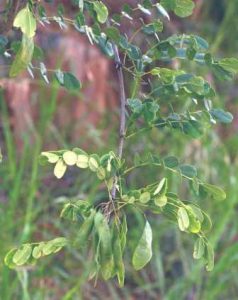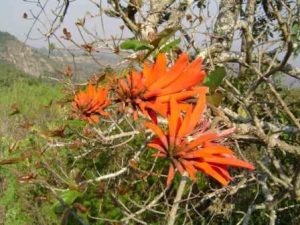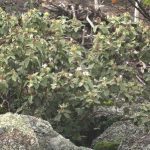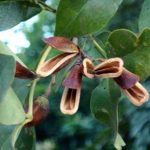TREE LIFE
NOVEMBER 1980
MASHONALAND BRANCH
Tuesday November 4th : Botanic Garden Walk. Meet in the car park at 1645 hours.
Saturday November 8th : Learner Group. An opportunity for members to visit an interesting site, under the guidance of Mrs. Gill Masterson. Time 0915 hours. Please phone Mrs. Masterson on 303435 to confirm the time and meeting place.
Sunday November 16th : Fox Farm, Glendale. Bus will leave Monomatapa Car Park at 0830 hours stopping at Reps Car Park at 0835 approximately. Fare will be $4.00 payable in advance. Book with Mrs. L. Irvine, Phone 21362.
Mr R. Arkell, a Tree Society member, has kindly invited us to Fox Farm on the 16th. Upon arrival tea will be served – please bring mugs, thereafter Mr. Arkell will show us the plantings of indigenous trees around the homestead, before taking us to the Mazoe River, by tractor and trailer. Here we will see some ‘different’ vegetation, as this point is at a lower altitude than Salisbury.
Tuesday December 2nd : In place of the Botanic Walk there will be an evening meeting. Mr. Tom Muller of the National Botanic Garden will give a talk entitled “Vegetation types of Zimbabwe” at 2000 hours in the upstairs auditorium of the Queen Victoria Museum.
Saturday December 6th : Learner Group meeting 0915. Please phone Mrs. Masterson to book and confirm. Phone 303435.
There will be no December outing.
BOTANIC GARDEN WALK TUESDAY 7TH OCTOBER
The party divided into two groups, one under the direction of Mr. R. Drummond, the other with Malcolm Leppard. I accompanied the latter group for a most enlightening demonstration of arboreal surgery techniques. Splitting and peeling back of bark on certain trees in the garden i.e. Stereospermum kunthianum is a problem at present defying explanation. Treatment with tree sealer seems to help in most cases. The specimen Pteleopsis myrtifolia in the gardens has recently sprouted a new species of fungus. A fine Acacia galpinii has been saved the blow of the axe with an elaborate treatment for a large rotting internal crack between the two main trunks. The crack itself was cleared of rotting matter, and sealed, the crown was thinned to reduce strain on the trunk, and the main branches braced with cables 2/3 of the way up.
We saw ‘drains’ in a fine old Albizia gummifera in the frequently sprayed forest sections. Mr. Leppard explained that the mass of rotting leaves caught in the hollows of these trees, finally causes rotting of the wood, so this debris is regularly cleared, and a pipe driven through to the base of the hollows, to drain any water. In the wild, such trees play host to epiphytes and fungi, but in the gardens where only a few of each species are grown, nature cannot always be allowed to take its course.
Of special interest was the palm, also saved from sure demise, this time by filling the hollowed and rotting stem with urethane foam. 2 liquids are mixed and react rapidly to form the foam which expands into all crevices.
EXTRA NOTES ON THE SEPTEMBER (MUNAKA PARK) VISIT
As promised in the October newsletter, a little more of this most interesting trip. Anton Ellert compiled a list of 94 species for this trip, 26 species of which were in fruit, and 18 in flower. Such careful recording of flowering and fruiting times of the trees is of immense value, and is an easy exercise to carry out when recording the species. Knowledge of our indigenous vegetation is far from complete, and every observation may be useful.

Dalbergia melanoxylon . Photo: Bart Wursten.
Source: Flora of Zimbabwe
Anton also noted the species of which Benedicta Graves displayed timber samples. These included the more well known timers like Khaya nyasica, Dalbergia melanoxylon and D. madagascariensis, Ziziphus mucronata and Faurea speciosa. There is still much to learn of our indigenous timbers, and they are presently under utilised, except of course, as firewood.
This trip brought forth a wealth of trees not often seen on our trips closer to Salisbury, Kirkia acuminata, Albizia tanganyicensis, Pterocarpus lucens subsp. antunesii and Stereospermum kunthianum , in beautiful flower.
VISIT TO BERNARD MZEKI SHRINE : OCTOBER 19TH 1980
Once again, the editor was unable to be on this trip, and I thank Anton Ellert for his notes and list of 83 tree species seen.
This was a joint visit with members of the National resources Board and the Wildlife society. The day was unusually overcast for October and there was a faint drizzle until about 0930 hours which was very welcome as it ensured that the outing was pleasantly cool for climbing ‘Pamusoro’ and the ‘Lekkerwater’ ruins in the afternoon.
The attraction for the Tree Society members was the ‘Riverine Forest” in a shallow valley on the side of a granite hill down which flows a small stream.
Dr. Penny Grant described how at one time the microclimate maintaining the forest was all but destroyed. However, after years of careful management, the forest has recovered.

Erythrina lysistemon. Photo:Bart Wursten.Source:Flora of Zimbabwe.
It is interesting to note that the wooden banana, Ensete ventricosum, had disappeared from the site but returned later, suggesting that the seed of this species has a viability of several years.
Two species of Cussonia, C. arborea and C. natalensis, were found. It seems seldom that we see any but the former. Three species of Erythrina, E. abyssinica, E. latissima and E. lysistemon, in the area were an interesting find, though it is possible that the E. lysistemon was introduced.
Crassocephalum manii was new to many. It is an under storey shrub and was in flower and fruit. The flowers are said to smell like dirty, sweaty socks!!
MAKABUSI WOODLANDS
The first AGM of the non profit making company falls due in November. We are very pleased to see so many Tree Society members associating themselves with this venture and would like to advise members that if they have not already done so, they may become “Friends of the Makabusi Woodlands” by making a one time only payment of two dollars, contributions to be sent to – The Membership Committee, Makabusi Woodland Association, P.O. Box 4665, Salisbury.
Further to our Tree Society contribution of $250 will shortly be paid over and we have undertaken to match this amount from the society’s resources with a dollar for dollar amount collected from members as a memorial to the Late Douglas Aylen who did so much to conserve the woodlands. We are about half way to this target so please any contributions to the Treasurer, P.O.Box 2128, Salisbury.
I am sorry to have to preface my remarks about the woodlands at present with such a long request for money but that is part of the environment in which we operate, shortage of money, for years now those of us responsible for projecting development of the woodlands have been hoping that once sanctions were removed some species of good fairy would flutter in from overseas and wave the proverbial magic wand and lo and behold; instant cash to build and develop in the woodlands. We now realise that we have been living in a fairy tale world. No cash is going to come from overseas, we have to supply what we can ourselves but in saying this I would like to stress that personally I am not pessimistic, looking back we have achieved a very great deal since Douglas won for us and posterity the right to keep the woodlands as a nature reserve, and if all will to help will pull together to keep what we have achieved and if we can only progress a little bit each year then that will be better than going backwards. Therefore we must continue to carry out the ‘holding’ operation basically, I personally believe, until such time as either central or municipal government assume their responsibilities and finance the woodlands to serve the function for which they are so admirably suited. Meanwhile in keeping good hold of what we have achieved so far, the woodlands is a delightful place, especially I think at this time of year, to walk there in thick bush so close to the hot and dusty city, it is easy to imagine oneself many miles away from civilisation. The Makabusi walkers are still active every Tuesday evening and the association has organised a system on honorary wardens to patrol the woodland under the leadership of Mr. Joe Bergkamp of Queensdale. I personally go and patrol the place, there is a very elusive poacher who we cannot catch but, by patrolling, we can worry him and stop him doing too much damage, the wardens are not only there to harass wrongdoers, they also carry out a very important task by greeting the casual wanderer in the woods and roughly explain the purposes of the woodlands. Should there be any volunteers from the ranks of our society to assist in this wardening I should be delighted to hear from you.
-George Hall.
MATABELELAND NOTES
Sunday November 2nd : To Toghwana Dam area, Rhodes Matopos National Park. Meet at Retreat at 0830 hours and bring lunch.
Saturday December 7th : Meet at Tshabalala Game Sanctuary gates at 0830 hours.
Sunday January 7th : To Lower Outspan Picnic Site, Rhodes Matopos National Park. Meet at Retreat at 0830 hours.
Notice is hereby given that the Annual General Meeting of the Matabeleland Branch of the Tree Society of Zimbabwe will be held on January 4th at approximately 1130 hours at the Lower Outspan Picnic Site, Rhodes Matopos National Park. The usual form of business will be considered and all members are asked to attend if possible.
Hillside Dams Walk : 2nd and 4th Wednesday. See September Tree Life for details.
MATOPOS NOTES
Rhodes Matopos National Park is a naturalists’ paradise; there is so much to see of interest that we are submitting a series of articles describing the different seasons. Rivers follow parallel courses towards the Limpopo River and there are more than five dams in the area. The rock formation varies enormously and many natural gardens occur. See The Matopos edited by the late Sir Robert Tredgold. We found an area high up on a kopje of Myrothamnus flabellifolia beneath which was a silver carpet of Selaginella, waiting for the rains to come. In another garden grew mauve flowering Vernonia and in yet another Aloe chabaudii bloomed profusely from the rock cracks.
Everywhere teems with interest; a drought adapted grass growing on the kopje called, I think, Petrina pruinosa, has narrow greyish leaves on the bare granite. It makes a nice cover for pythons, and when climbing steep inclines is to be avoided because of its slipperiness
Winter colours are present in the dark wine red of Faurea saligna in valleys, in the Pterolobium stellatum wings, in the yellow brown of the leaves of Pavetta eylesii and these have traces of last season’s fruits hanging. The rocks with their crops of lichen are a study with dozens of colour; white, grey, black, yellow, brilliant orange and a variety of shades of green, practically a rainbow of colour. Frosted trees provided bright colour, notably Colophospermum mopane, a rich brown, and Pseudolachnostylis maprouneifolia gleamed in the sun, one bright even red colour.
This winter there have been many Phymateus viridipes, the green locust with the colourful flash in flight, and one attempted to land on my green hat while I was walking over a granite dwala, lashing my face with its wings; I lost time in turning my hat inside out to present a different colour! While walking up the kloof which runs at the southern end on Bambata hill we heard the repeated hammering of a wood pecker. It was probably a Golden-tailed Woodpecker, resplendent with red cap, yellow spotted back and tail divided and a little frayed from being held against tree trunks during pecking operations. August is their nest building time, and investigations revealed a hole drilled into a dead branch of a duikerberry tree which was growing in a dry and rocky riverbed. Large chips of wood lay on the rock below; making a nest hole even in the dead wood is no mean feat. Signs of another ‘carpenter’ were found where a porcupine had gnawed the superficial roots of Lannea discolor.
It was a nice surprise to find the Maleme river tributary flowing over the weir, even though it was August, and the sound of water tinkling as it fell down the steep slope was very pleasant. The river appears and disappears on this hill and at the base it winds around towards the Maleme Dam, on its way offering many drinking pools for birds and animals and places for pond skaters. The tree growth provides variety at every step and the following things are abundant there; tangly Pterolobium stellatum, Fagara capensis, Brachylaena rotundata, Croton gratissimus, Mimusops zeyheri, Heteropyxis natalensis, Ficus capensis, Olea and many others.
A NATIONAL TREE PLANTING DAY ZIMBABWE
The Prime Minister, Mr. Robert Mugabe, has announced a National Tree Day of 6th December, 1980 and this should be an annual event from now on.
The main impetus for this event comes from the Natural Resources Board, who have issued a folder to a range of officials. It asks that everyone, try, in any way possible, to organise some sort of ceremony or tree planting effort on that day.
The Tree Society will obviously try to help out wherever possible, and it is hoped the members throughout the country will organise a “tree event”, no matter how small.
The nearest Forestry Commission or Devag office will be pleased to answer queries or give advice and the Tree Society committee would welcome the ideas and suggestions of members.
Unfortunately, many school children may already be on holiday on that day, but, there is no reason why individual schools or teachers should not organise their tree planting at some earlier date.
Having heard so many recent complaints from people about the waste of energy of the interminable sponsored walks, may I suggest to teachers that sponsored tree plants may be of more value, and obtain larger sponsorship from the public.
GEORGE HALL CHAIRMAN



